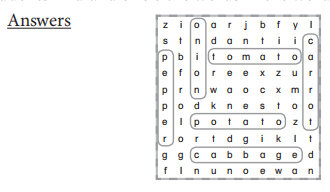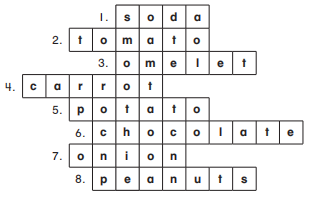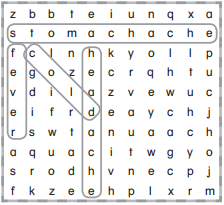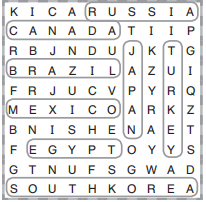Welcome, pages 2-3
A. Circle.
Students look at the pictures and circle the correct words or phrases, completing the sentences.
Answers
1. I'm doing my homework in the kitchen.
My favorite subject is science.
2. I'm wearing a dress and shoes.
I'm listening to music. It sounds good.
3.Were playing the guitar.
We go to music class on Fridays.
B. What about you? Write.
Students write sentences about themselves.
C. Read and match.
Students draw lines, matching the pictures to the sentences and words.
Answers
1. C, sixteenth
2. f, eighth
3. a, twentieth
4. d, seventh
5. b, third
6. e, twenty-first
D. Unscramble.
Students look at the pictures, unscramble the words, and then write sentences.
Answers
1. Take a test.
2. Check your homework.
3. Study for a test.
4. Hand in your homework.
Unit 1 Things to Eat
Lesson 1, Snacks, pages 4-5
A. Circle.
Students look at the pictures and circle the answers.
Answers
1. potato chips
2. peanuts
3. gum
4. chocolate
5. soda
6. popcorn
B. Write.
Students look at the pictures and write the answers.
Answers
1. popcorn
2. chocolate
3. gum
4. soda
5. potato chips
6. peanuts
C. Read and match.
Students draw lines, matching the sentences to the pictures.
Answers
1. e
2. b
3.f
4. d
5. a
6. C
D. Write.
Students look at the pictures and complete or write the questions and answers.
Answers
1. What does he want? He wants some gum.
2. What does she want? She wants some potato chips.
3. What does she want? She wants some popcorn.
4. What does he want? He wants some soda.
Lesson 2, Vegetables, pages 6-7
A. Find and circle.
Students find and circle the words in the word search.

B. Write.
Students look at the pictures and complete or write the questions and answers.
Answers
1. Do you need any carrots? Yes, we do.
2. Do you need any tomatoes? No, we don't.
3. Do you need any potatoes? Yes, we do.
4. Do you need any onions? Yes, we do.
5. Do you need any cabbages? No, we don't.
6. Do you need any peppers? No, we don't.
C. What do they need? Circle.
Students look at the pictures and circle the correct words,completing the sentences.
Answers
1. They need some carrots.
2. They need a potato.
3. They need an onion.
4. They need some peppers.
5. They need some tomatoes.
6. They need a cabbage.
D. Write.
Students look at the pictures and write the sentences.
Answers
1. What do they need?
They need a carrot.
2. What do they need?
They need some potatoes.
3. What do they need? .
They need some cabbages.
4. What do they need?
They need a tomato.
5. What do they need?
They need a pepper.
6. What do they need?
They need some onions.
Lesson 3, Story, pages 8-9
A. Number.
Students number the pictures in the correct order.
Answers
1. What's for lunch?
2. Soup and salad.
3. That sounds good.
4. Yum! This tastes good.
B. Find and write.
Students complete or write the sentences, using the key, and then draw lines, matching the sentences to the pictures.
Answers
1. What's for dinner?
Steak and french fries.
That sounds good.
2. What's for lunch?
Salad and soup.
That sounds good.
3. What's for dinner?
Bread and spaghetti.
That sounds good.
4. What's for lunch?
Bread and soup.
That sounds good.
C. Write.
Students complete the sentences by using the key.
Answers
1. Vegetables are very good for you.
2. Yum! This tastes good.
3. Just try it.
4. I want some french fries.
D. What about you? Write.
Students write sentences about themselves.
Lesson 4, Cooking, pages 10-11
A. Write.
Students look at the pictures and write the answers.
Answers
1. smoothie
2. omelet
3. milkshake
4. fruit salad
B. Unscramble.
Students unscramble the words and write the sentences.
Answers
1. I want to make a fruit salad.
2. I want to make a smoothie.
3. I want to make a milkshake.
4. I want to make an omelet.
C. What do you need? Write.
Students look at the pictures and write the sentences.
Answers
1. I need some bananas and some yogurt.
2. I need some eggs and some milk.
3. I need some milk and some ice cream.
4. I need some oranges and some peaches.
D. Look at C . Write.
Students look at exercise C and complete or write the sentences.
Answers
1. I want to make a smoothie.
2. I want to make an omelet.
3. I want to make a milkshake.
4. I want to make a fruit salad.
Unit 2 Around Town
Lesson 1, Places to Go, pages 12-13
A. Match.
Students draw lines, matching the words to the pictures.
Answers
1. f
2. d
3. e
4. a
5. b
6. C
B. Unscramble.
Students unscramble the letters and write the words.
Answers
1. department store
2. library
3. movie theater
4. post office
5. supermarket
6. park
C. Circle.
Students look at the pictures and circle the correct answers.
Answers
1. Where's the post office?
It's across from the library.
2. Where's the park?
It's across from the supermarket.
3. Where's the department store?
It's across from the movie theater.
D. Write.
Students look at the pictures and complete or write the questions and answers.
Answers
1. Where's the department store?
It's between the park and the supermarket.
2. Where's the movie theater?
It's between the post office and the library.
3. Where's the post office?
It's between the supermarket and the movie theater.
E. Read and match.
Students match the sentences to the pictures.
Answers
1. The department store is across from the supermarket.[2nd picture]
2. The library is between the park and the post office.[3rd picture]
3. The park is across from the movie theater. [1st picture]
Lesson 2, Things to Do, pages 14-15
A. Circle.
Students circle the correct answers.
Answers
1. buy groceries
2. borrow books
3. kick a ball
4. mail letters
B. Look at A. Circle.
Students circle the answers to complete the sentences.
Answers
1. What's she doing at the supermarket?
She's buying groceries.
2. What's he doing at the library?
He's borrowing books.
3. What's she doing at the park?
She's kicking a ball.
4. What's he doing at the post office?
He's mailing letters.
C. Write.
Students look at the pictures and write the sentences.
Answers
1. What are they doing at the supermarket?
They' re buying groceries.
2. What are they doing at the movie theater?
They're watching a movie.
3. What are they doing at the park?
They're kicking a ball.
4. What are they doing at the department store?
They're shopping.
5. What are they doing at the library?
They're borrowing books.
6. What are they doing at the post office?
They' re mailing a letter.
Lesson 3, Story, pages 16-17
A. Number.
Students number the pictures in the correct order.
Answers
1. Excuse me. Where's the library?
2. The library? I's over there.
3. Ah! I see it. Thank you.
B. Read and match.
Students draw lines, matching the sentences to each other and completing the conversations.
Answers
1. Excuse me. Where's the post office?
It's over there.
2. Where's the supermarket?
It's between the library and the movie theater.
3. The park? It's over there.
I see it. Thank you!
C. Unscramble.
Students unscramble the letters and write the sentences.
Answers
1. Excuse me. Where is the library?
2. It's over there.
3. I see it. Thank you
D. Read and draw.
Students draw pictures, illustrating the sentences.
Lesson 4, Activities, pages 18- 19
A. Find and circle.
Students find and circle the words in the word search.
Answers

B. Write.
Students look at the pictures and complete or write the sentences.
Answers
1. First, cut the paper.
2. Next, fold the paper
3. Then, color the paper.4. Finally, glue the paper.
C. Unscramble.
Students unscramble the words and write the sentences.
Answers
1. First, color the flowers.
2. Next, cut the flowers.
3. Then, fold the flowers.
4. Finally, glue the flowers.
D. Read and number.
Students number the pictures in the correct order.
Answers
1. First, fold the paper.
[1st column, 1lst picture]
2. Next, cut the paper.
[1 st column, 2nd picture]
3. Then, glue the paper.
[2nd column, 2nd picture]
4. Finally, draw and color the book.
[2nd column, 1st picture]
Check Up 1, pages 20-22
A. Number.
Students use the key to number the pictures.
Answers
1. fold [bottom row, fourth picture]
2. shop [top row, third picture]
3. milkshake [top row, fifth picture]
4. gum [bottom row, first picture]
5. move theater [bottom row, third picture]
6. pepper [top row, first picture]
7. peanuts [bottom row, fifth picture]
8. post office [top row, fourth picture]
9. borrow books [top row, second picture]
10. onion [bottom row, second picture]
B. Read, check, and match.
Students complete the sentences by looking at the pictures and using the key.
Answers
1. Glue, d
2. want to make, c
3. between, b
4. They're, a
C. Write.
Students look at the pictures and complete the sentences.
Answers
1. What do they need?
They need carrots.
2. Where is the supermarket?
It's across from the park.
3. What does he want?
He wants popcorn.
4. What does he do at the park?
He plays soccer.
D. Look at the pictures. Write.
Students fill in the correct answers.
Answers
1. What's for dinner?
Spaghetti and salad.
That sounds good.
2. Excuse me.
Where's the movie theater?
It's over there.
E. Write.
Students write about themselves.
F. Unscramble the food words. Do the puzzle. Write.
Students unscramble the words and fill in the puzzle.
Answers

I want to make a smoothie!
Skills Bonus 1, page 23
A. Read and circle.
Students read the passage and circle the correct answers.
Answers
1. Yes 2. No 3. Yes 4. No
B. What about you? Look at A. Write.
Students look at exercise A as an example and complete
the sentences, writing about themselves.
Unit 3, People in Town
Lesson 1, Occupations, pages 24-25
A. Write.
Students look at the pictures and write the answers.
Answers
1. postal worker
2. salesperson
3. vet
4. cashier
5. server
6. librarian
B. Read and circle.
Students look at the pictures and circle the correct answers.
Answers
1. Yes, he is.
2. No, she isn't
3. Yes, he is.
4. No, she isn't.5. No, they aren't.6. Yes, they are.
C. Write and number.
Students write sentences and number the pictures.
Answers
1. Who works at the post office?
The postal worker works at the post office.
[2nd picture]
2. Who works at the library?
The librarian works at the library.
[1st picture]
3. Who works at the supermarket?
The cashier works at the supermarket.
[4th picture]
4. Who works at the restaurant?
The server works at the restaurant.
[3rd picture]
D. Match and write.
Students draw lines, matching the sentences to the picture, and then write the answers.
Answers
1. [2nd column, 2nd picture]
animal hospital
2. [1st column, 2nd picture]
department store
3. [2nd column, 1st picture]
restaurant
4. [1st column, 1st picture]
library
Lesson 2, What People Do, pages 26-27
A. Match.
Students draw lines, matching the words to the pictures.
Answers
1. e
2. c
3. b
4. d
5. a
6. f
B. Unscramble. Then answer.
Students unscramble the words and write the questions.Then, write the answers.
Answers
1. What does the salesperson do?
The salesperson sells things.
2. What does the pilot do?
The pilot flies planes.
3. What does the firefighter do?
The firefighter fights fires.
4. What does the bus driver do?
The bus driver drives buses.
5. What does the vet do?
The vet helps sick animals.
6. What does the cook do?
The cook makes food.
C. Connect.
Students draw lines, connecting the two halves of the questions, given the answers.
Answers
1. Does the cook - make food?
Yes, she does.
2. Does the salesperson - fight fires?
No, she doesn't.
3. Does the pilot - fly planes?
Yes, he does.
4. Does the bus driver - help sick animals?
No, he doesn't.
5.Does the firefighter - fight fires?
Yes, she does.
6.Does the vet - sell things?
No, he doesn't.
D. Look at C. Number.
Students look at exercise C and number the pictures.
Answers
Top row: 6, 1,5
Bottom row:4,3, 2.
Lesson 3, Story, pages 28-29
A. Number.
Students number the sentences in the correct order.
Answers
1. We don't have a present for Dad.
2. We can make a present!
3. Dad, this is for you.
4. It's beautiful! Thank you.
B. Unscramble.
Students unscramble the words and write the sentences.
Answers
1. We don't have a present for Mom.
2. We can make a present.
3. Mom, this is for you.
4. It's beautiful! Thank you.
C. Read and match.
Students draw lines, matching the sentences to the pictures.
Answers
1. c
2. d
3.b
4. a
D. Write.
Students look at the pictures and complete or write the sentences, using the key.
Answers
1. How much is this sweater? I's $25.
2. How much are these shoes? They're $55.
3. How much is this book. It's $2.
4. How much are these pencils? They're $6.
E. What about you? Write.
Students write sentences about themselves.
Lesson 4, Illnesses, pages 30-31
A. Look at the pictures. Find and circle.
Students find and circle the words in the word search.
Answers

B. Look at A. Circle and write.
Students look at the pictures in exercise A, circle the correct words, and then write the sentences.
Answers
1. What the matter with him?
He has a stomachache.
2. What the matter with her?
She has a fever.
3. What's the matter with him?
He has a headache.
4. What's the matter with her?
She has a cold.
C. Write.
Students look at the pictures and write the sentences.
Answers
1. What's the matter with her?
She has a cold.
2. What's the matter with him?
He has a fever.
3. What's the matter with her?
She has a headache.
4. What's the matter with him?
He has a stomachache.
D. Look and write.
Students look at the chart and write the sentences.
Answers
1. Mark has a stomachache.
2. Ken has a cold
3. Eva has a fever.
4. Carol has a headache.
Unit 4 Getting Together
Lesson 1, Family, pages 32-33
A. Unscramble.
Students unscramble the letters and write the words.
Answers
1. grandparents
2. parents
3. aunt
4. uncle
5. cousin
6. cousin
B. Do the puzzle.
Students use pictures to write the words in the puzzle.
Answers

C. Look at B . Read and number.
Students look at the pictures in exercise B and number the sentences.
Answers
1. They re Dean's grandparents.
2. He's Dean's cousin.
3. She's Dean's cousin.
4. She's Dean's aunt.
5. They're Dean's parents.
6. He's Dean's uncle.
D. Write.
Students look at the pictures and complete or write the sentences.
Answers
1. Who's she?
She's Dean's aunt.
2. Who's he?
He's Dean's cousin.
3. Who are they?
They're Dean's grandparents.
4. Who are they?
They're Dean's parents.
5. Who's she?
She's Dean's cousin.
6. Who's he?
He's Dean's uncle.
Lesson 2, Things on the Table, pages 34-35
A. Write.
Students write the words, using the key.
Answers
1. fork
2. knife
3. plate
4. bowl
5. spoon
6. cup
B. Write and circle.
Students look at the pictures and complete or write the sentences.
Answers
1. This spoon is mine.
2. This fork is yours.
3. This plate is hers.
4. This spoon is his.
C. Unscramble and match. Then write.
Students unscramble the letters and write the sentences.Then, students draw lines, matching the questions to the pictures, and write the sentences.
Answers
1. Whose plate is that?
[2nd picture] It's mine.
2. Whose fork is that?
[1st picture] It's hers.
3. Whose knife is that?
[3rd picture] It's yours.
4. Whose bowl is that?
[4th picture] It's his.
D. Write.
Students look at the pictures and complete or write the sentences.
Answers
1. Whose cap is this? It's my cap.
2. Whose ruler is this? It's her ruler.
3. Whose coat is this? It's his coat.
4. Whose book is this? It's my book.
Lesson 3, Story, pages 36-37
A. Number.
Students number the sentences in the correct order.
Answers
1. Whose noodles are these?
They' re mine.
2. Where's my fork?
3. What are these?
They're chopsticks.
4. How do you use chopsticks?
Like this.
B. Read and match.
Students draw lines, matching the sentences to the other sentences and the pictures.
Answers
1. Whose noodles are these? - They're mine.
[1st column, 2nd picture]
2. Thanks, Mom! - No problem.
[1st column, 1st picture]
3. What are these? - They re chopsticks.
[2nd column, 2nd picture]
4. How do you use chopsticks? - Like this.
[2nd column, 1st picture]
C. Write.
Students look at the pictures and complete the sentences,using the key.
Answers
1. How do you play the guitar? Like this.
2. How do you use a computer? Like this.
3. How do you make a smoothie? Like this.
4. How do you ride a bike? Like this.
D. What about you? Write.
Students write sentences about themselves.
Lesson 4, Countries, pages38-39
A. Find and circle.
Students find and circle the words in the word search.
Answers

B. Circle.
Students look at the pictures and circle the correct words.
Answers
1. Were from Mexico. This flag is ours.
2. They're from Japan. That flag is theirs.
3. We're from Turkey. This flag is ours.
4. They're from Russia. That flag is theirs.
C. Match and write.
Students look at the pictures, complete or write the sentences, and then match the pictures to the sentences.
Answers
1. b. We're from Russia.
This flag is ours.
2. d. They're from Japan.
That flag is theirs
3. a.We're from Mexico.
This flag is ours.
4.c. They re from Turkey.
That flag is theirs.
D. Read.Then write and draw.
Students read the sentences, write the name of the country, and then draw a picture of that country's flag.
Answers
1. Mexico
2. Japan
3. Russia
4. Turkey or Japan
Check Up 2, pages 40-42
A. Check.
Students look at the pictures and choose the correct answer.
Answers
1. salesperson
2. cousin
3. headache
4. Japan
5. spoon
6. drive buses
B. Read and write.
Students look at the pictures and complete the sentences.
Answers
1. This is our flag.
2. She's Dean's cousin.
3. The server works at the restaurant.
4. It's mine.
C. Write and match.
Students match the sentences with the pictures, then fill in the answers.
Answers
1. She has a headache. d
2. The salesperson works at the department store. c
3. The pilot flies planes. b
4. The vet helps sick animals. a
D. Look at the pictures. Write.
Students fill in the conversations using the key.
Answers
1. Excuse me.
How much is this coat?
It's $45.
2. How do you play the guitar?
Like this.
E. Write.
Students write about themselves.
Skills Bonus 2, page 43
A. Read and circle.
Students read the passage and circle the correct answers.
Answers
1. No
2. Yes
3. No
4. Yes
B. What about you? Write.
Students answer the questions, writing sentences about themselves.
